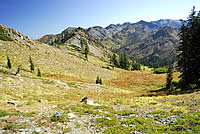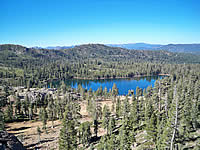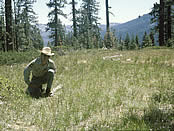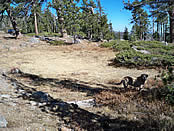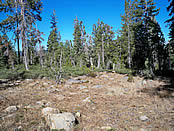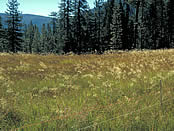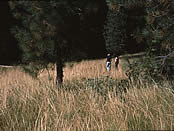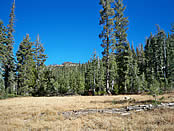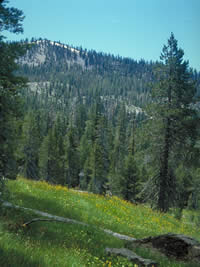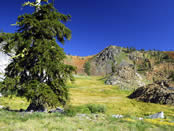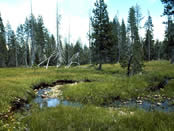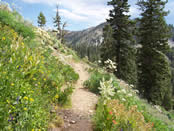USDA Forest Service Celebrating Wildflowers
|
|
|
Serpentine Meadows
Meadows can be found at almost any elevation on serpentine soils in the Klamath-Siskiyou region. The differences in species composition among three general meadow types - dry, moist, and wet - are mostly determined by how long soil moisture is available into the growing season. There are local meadow endemics associated with each of the principal geologic features of the region - the Josephine Ophiolite, the Rattlesnake Creek Terrane, and the Trinity Ophiolite. Dry MeadowsDry meadows are wet in the spring, but their shallow, rocky soils dry out by early summer. Their meadow appearance is created by a low cover of grasses, such as oatgrass (Danthonia spp.), Idaho fescue (Festuca idahoensis), and squirreltail (Elymus elymoides), among which grow spring-blooming wildflowers such as spreading phlox (Phlox diffusa), violets (Viola lobata, Viola purpurea), fleabane (Erigeron lassenianus), skullcap (Scutellaria antirrhinoides), and the serpentine endemic fern, Aspidotis densa. These dry meadows are common in mid to upper elevations, where cool temperatures and snowmelt allow soil moisture to linger long enough for grasses and wildflowers to bloom and reproduce before the dry season comes. Rare plants associated with dry serpentine meadows include threadleaf beardtongue (Penstemon filiformis) and Scott Mountain phacelia (Phacelia dalesiana). Dry meadows are absent from the drier, hotter serpentine landscape of the southern Rattlesnake Creek Terrane, where shallow rocky soils produce barrens with very little vegetation at all.
Moist MeadowsMoist meadows stay wet longer into the summer, sometimes being spring-fed. These meadows have taller vegetation, characterized by tufted hairgrass (Deschampsia cespitosa) and a diverse sedge (Carex spp.) component. Wildflowers such as Bigelow sneezeweed (Helenium bigelovii), rush lily (Hastingsia alba), Brewer swamp thistle (Cirsium douglasii var. breweri), blue-eyed grass (Sisyrinchium spp.), and tall Indian paintbrush (Castilleja miniata) bloom well into the summer. Rare plants found in moist meadows include California lady’s slipper (Cypripedium californicum) and Oregon willowherb (Epilobium oreganum). Moist meadows are found on serpentines throughout the Klamath-Siskiyou bioregion, from low elevations to the subalpine zone.
Wet MeadowsThe wettest meadows have water year-round and are associated with perennial springs, seeps, and streams; in some cases, there is enough peat accumulation to create true fens. Raised hummocks are inhabited by shrubs, especially heath family members including western azalea (Rhododendron occidentale), laurel (Kalmia polifolia var. microphylla), Labrador tea (Ledum glandulosum), and huckleberries (Vaccinium spp.). The squishy wet parts are full of sedges, rushes, asters, grass-of-Parnassus (Parnassia spp.), golden bog asphodel (Narthecium californicum), western tofieldia (Tofieldia occidentalis), primrose monkeyflower (Mimulus primuloides), California coneflower (Rudbeckia californica), and leopard lily (Lilium pardalinum), and several gentians (Gentiana, Gentianopsis, and Gentianella spp). Most of the moist meadow species are also present in wet meadows as well, along the margins or away from spring-fed channels. Above 7,400 feet on Mt. Eddy, wet meadows pick up characteristic subalpine species such as mountain heather (Phyllodoce empetriformis) and white heather (Cassiope mertensiana), both of which are shared by the nearby southern Cascades volcano, Mt. Shasta. One and the SameWet meadows and Darlingtonia wetlands overlap like a Venn diagram, i.e. some Darlingtonia grows in wet meadows and some wet meadows have Darlingtonia. Neither is completely a subset of the other. Read more » Rare plants found in wet meadows and restricted to the Josephine Ophiolite (northwest California and southwest Oregon) include Waldo gentian (Gentiana setigera), western bog violet (Viola primulifolia ssp. occidentalis), Siskiyou Indian paintbrush (Castilleja miniata ssp. elata),), and purple-flowered and large-flowered rush lilies (Hastingsia bracteosa var. atropurpurea, Hastingsia bracteosa var. bracteosa). Showy raillardella (Raillardella pringlei) is limited to wet meadows of the Trinity Ophiolite. California lady’s slipper (Cypripedium californicum) and Oregon willowherb (Epilobium oreganum) are rare plants distributed across the Klamath-Siskiyou bioregion’s wet meadows, from west to east, north to south, and low to high elevations. Perennially wet meadows are one kind of home to the strangely attractive, carnivorous Darlingtonia californica, but Darlingtonia is not always present in wet meadows. While Darlingtonia dominates in nitrogen-poor fens with a built up organic layer of sphagnum moss, in wet meadows, Darlingtonia hugs the edges of springs and cold water channels where constant water flow disturbs the soil enough to keep the sedges and grasses from establishing their turf. On mountain slopes underlain by fractured ultramafic bedrock, Darlingtonia seeps often interfinger with Port-Orford-cedar or montane mixed conifer forests. For a hiker in serpentine country, walking a forested trail with a tantalizing glimpse ahead of sunny meadows means you may get your feet wet soon, surrounded by the weird Darlingtonia, fragrant western azaleas, and giant California coneflowers. Photo Gallery |
|
| NOTE: PDF format links require the Adobe Acrobat Reader to view. | |
| top | Disclaimers | FOIA | Privacy Policy | Quality of Information | Photo Credits & Use |
Location: http://www.fs.fed.us/wildflowers/communities/serpentines/communities/meadows.shtml
Last modified: Wednesday, 03-Dec-2008 13:54:23 EST
